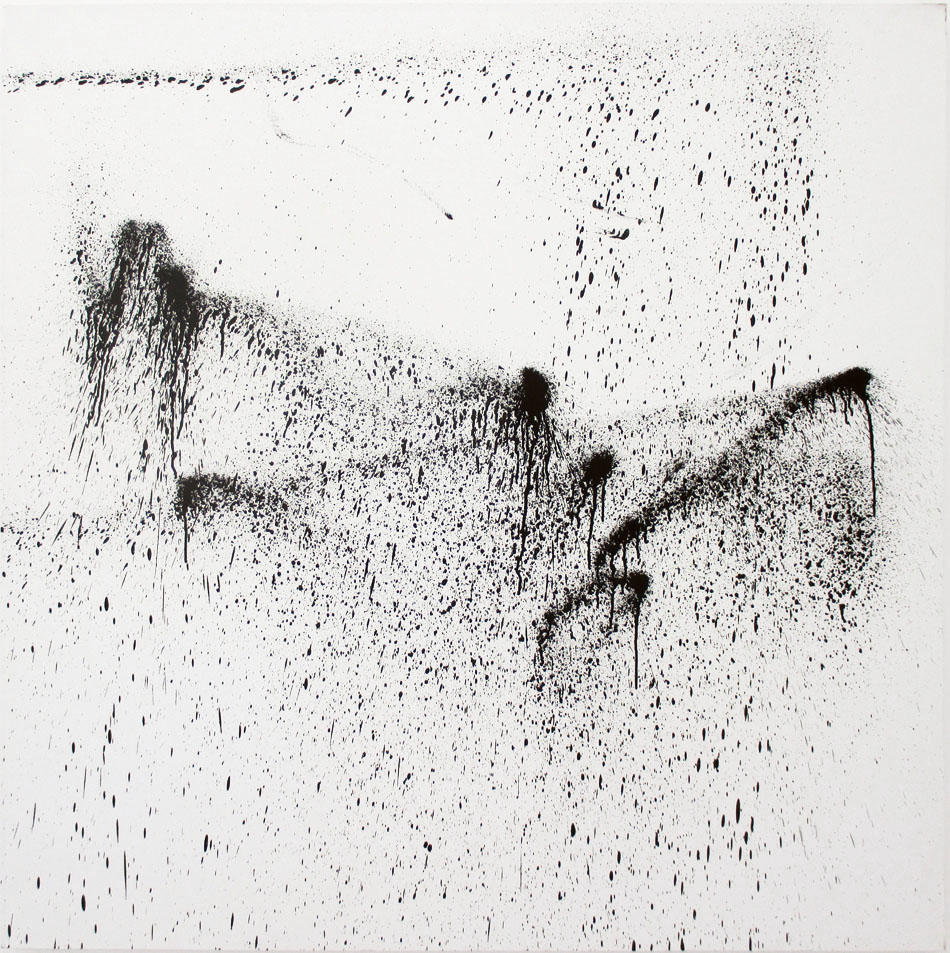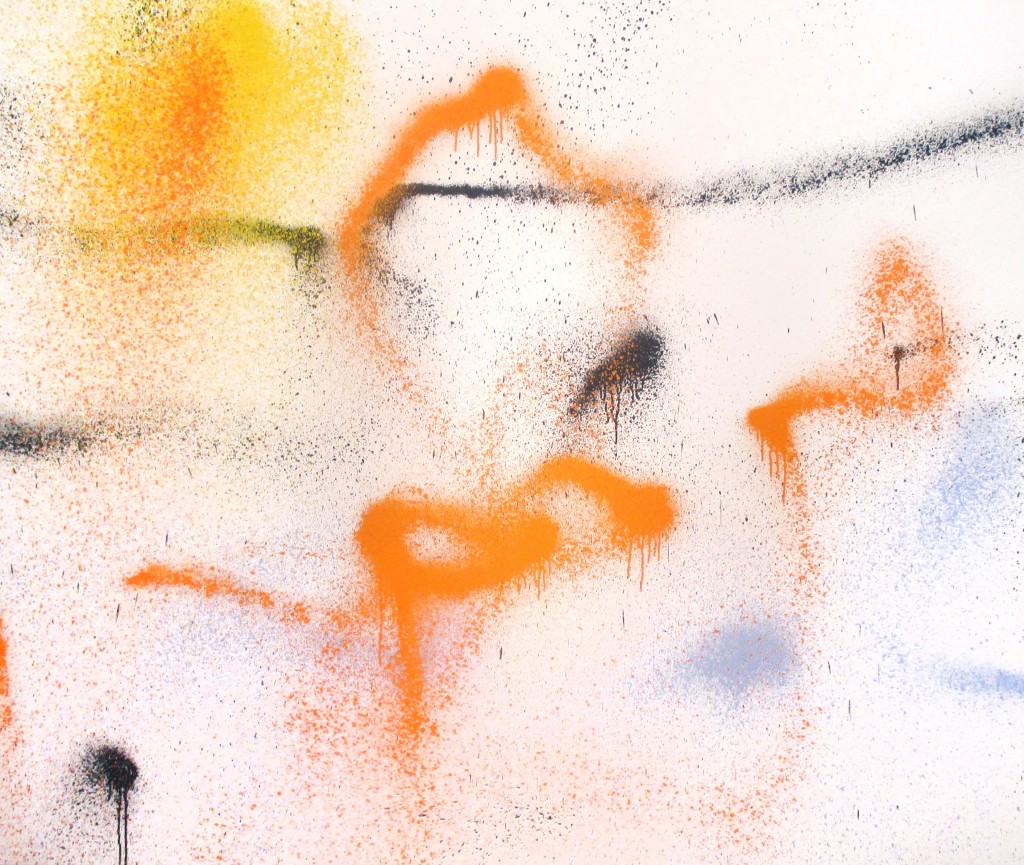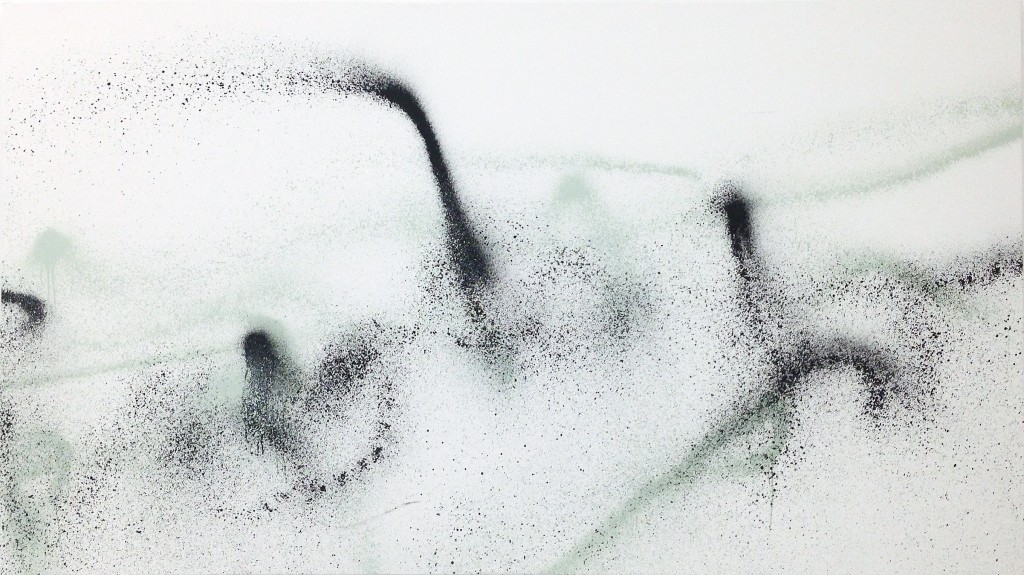Published in conjunction with Motherboard.- VICE
https://www.youtube.com/watch?v=7vZzqjKIBNc
KATSU is an artist and vandal. His work pushes our idea of what can be achieved with the graffiti artist’s limited tool set. Having established himself as one of New York City’s most prolific and imaginative taggers in the 1990s, KATSU garnered admiration from the arts community (and condemnation from the authorities) when he pioneered the fire extinguisher spray can, which has permitted him to expand the scale of his art by orders of magnitude. Most famously and notoriously, in 2012 KATSU brought his fire extinguisher to “Art in the Streets” show at the the Los Angeles Museum of Contemporary Art and left his multiple-story calling card on the side of the museum.
In his bid to find innovative ways to extend the artist’s reach to previously inaccessible spaces, KATSU, who is a member of the online free culture and technology collective F.A.T Lab, has projected his art out of the material world and into digital sphere. In 2013, he started placing his graffiti tags in the video game Minecraft. Indeed, he has even tagged an entirely imaginary space: in 2010, he created fake (but very realistic) videos of himself spray painting the White House (video below) and a Picasso. Briefly, many in the art world were fooled.
KATSU’s new project is not fake or hypothetical, though it does elevate his work to new heights. He has developed a system to attach a spray can to a quadcopter, creating the world’s first true graffiti drone. The drone is capable of spraying canvases or walls hundreds of feet tall, granting the artist access to physical spaces that were previously inaccessible. At the Silicon Valley Contemporary art fair, which opens April 10, KATSU will show a series of canvasses that he created with his graffiti drone.
Just as autonomous drone technology in the military sphere will challenge structures of accountability and responsibility, KATSU’s graffiti drone, which he hopes will soon be capable of autonomously creating its own artworks, challenges our notions of authorship, creativity and power: Who’s the artist, the human or the machine? Likewise, just as the drone has expanded the physical and surveilant reach of militaries and governments, in the cities where artists constantly seek to place their artwork in the most unreachable places, the drone could become a powerful tool of art and vandalism. Soon, artists everywhere can test the drone for themselves, as KATSU plans to develop the machine as an open-source technology.
KATSU’s work has appeared in cities internationally. He is represented by The Hole gallery in New York City. This weekend, KATSU may or may not test the drone, unannounced, on the corporate edifices of Silicon Valley.

Interview by Arthur Holland Michel
Center for the Study of the Drone What are you actually going to do with the drone?
KATSU A lot of my work comes out of demonstrating and experimenting with different technologies for creative use. Basically, drones have lowered in cost enough that they are attainable, so I got my hands on some DJI Phantom 2s, and I have been experimenting with the idea of using drones to accomplish the same things that drones are beginning to be used for in broader society, but in this case for crime, vandalism, art. I really want to look into the way that a person and a drone could connect. I thought, ‘I could go out into the city and spray paint using a drone wherever I wanted to, in basically unreachable spots and in unusable areas.’
I also had a desire to make a series of paintings that would begin to express what happens when technology begins to collaborate in artistic creation and disruption.
I started to collaborate with some developers and hardware people that I’m friends with, and we started working with Arduinos and 3-D printing, and basically raced to create this prototype remote sprayer that works with a drone. I attached a cradle with a spray paint can and other hardware to the drone. I created a series of paintings that are larger, about maybe 3 feet by 3 feet all the way up to 25 feet by 15 feet. Those served as this arena for experimentation, where I was testing out the system. And basically, I achieved the perfect air pressure, the perfect weight of the paint and the perfect materials so that the drone didn’t freak out when I attached these mechanisms to it.

Enamel on canvas
48 x 48 inches
“It’s like 50 percent me having control and 50 percent the drone kind of like saying, ‘I need to turn this way to accomplish what you want me to do but still maintain myself so I don’t just fly into the wall and explode.’ Which it does, all the time.”
Drone How much is up to the drone, in terms of the ultimate form? Do you find that you have pretty strict control over how the piece looks, or does the drone do its own thing?
KATSU To a large degree, it’s up to the drone. It’s like, I’m telling this device to basically accommodate this new attached payload that has an unusual shape, which then changes the drone’s shape. The drone is suddenly trying to adjust in real-time to the decreasing weight of the paint as the can empties. The flight patterns, the gestures, are my control. But it’s really strange–it’s weird, bizarre: it’s like 50 percent me having control and 50 percent the drone kind of like saying, ‘no I need to go this way’ or ‘I need to bounce out this way’ or ‘I need to turn this way to accomplish what you want me to do but still maintain myself so I don’t just fly into the wall and explode.’ Which it does, all the time; well, it’s doing it less and less now that I’m getting a better relationship with it.
So the gestures that are being created—the lines, the strokes, the patterns—they’re really unusual. They’re really exciting to come back to and reflect on over and over and over, because you pick up all these little details and nuances. You begin to understand that this really can only be accomplished through this bizarre dance between me controlling the drone and the drone doing its own thing.
I’m not putting in a preprogrammed flight pattern. That is a 2.0 or a 3.0 desire that I have for the project. But right now it really is kind of this 50/50 relationship.

Enamel on canvas
60 x 71 inches
Drone So at some point you might want to actually put a program into the drone, so that it flies up and does the whole thing without any of your intervention?
KATSU To a certain degree. The use of the drone needs to be half a project of innovation and half a project of expression. In no way will I think programming the drone to go and execute or render a pre-programmed image will ever have more value than these canvases in this painting series that I’ve created now with my direct input, but I do have this little video game-inspired fantasy of lying in my bed, sending my drones out my bedroom window, having them render my tags all over the city and then flying back home to me, like, in my bed. The idea would be to eventually create a drone that has a free flight mode that allows either for more collaboration with the drone or less collaboration with the drone, and then potentially a dual flight mode, where I can have the freedom to get the drone where it needs to be and then put it into a new flight mode to maybe execute a tag or something that almost looks hand-drawn.
“The undercovers drove by in a cab, and they were looking at me and looking at this drone and going by at this weird six and a half mile per hour roll, and you could just see it on their faces that they were really mesmerized and confused and scared and excited, all at the same time.”
Drone Part of the idea is that you want to get your tags to more inaccessible places, then? The work with the fire extinguishers was part of that desire. I mean, with a drone you’re going to be able to really get the paint to places that no one would really be able to with the previously existing means.
KATSU I think that’s part of the point of creating this: pushing the possibilities. Finding ways to further monitor and explore the situation with technology, drone technology. Because we’re in this weird period where people don’t know what drones really are,the general public doesn’t really understand the implications of what drones are and what they can do. There aren’t any clear laws right now. I was test-flying my drone down on Houston St. and these DTs—the undercovers—drove by in the cab, and they were looking at me and looking at this drone and going by at this weird six and a half mile per hour roll, and you could just see it on their faces that they were just really mesmerized and confused and scared and excited, all at the same time.
As an artist and a graffiti writer, I want to push to make the drone a tool that I can use, but it’s also a bit of a statement. You know, I hope that I put enough of the elements together so that I can release this thing soon, in all its open-sourcesness, to allow graffiti writers and other artists around the world to rapidly start experimenting and iterating this and start playing with it.
Drone Open-source technology is central to the drone hobbyist culture. Was that part of the allure for you, given your extensive background in creating open-source products?
KATSU I’ve never been interested in creating works to hold tightly and keep ownership of. I just have an uncontainable excitement for seeing magic happen in front of me, and I think that there’s nothing that I want more than to see people either react to this or find flaws in it or find ways to just really blow this concept up. It’s just sheer excitement about the possibilities.
Drone Is part of this project a statement about the drone? Are you trying to communicate something about the technology itself, rather than it being simply an experiment using this technology?
KATSU There’s a much deeper meaning for me personally with this drone and these paintings, where they are going and what they mean to me artistically. I think drones are becoming this extension of human beings in the same way that we’re growing so close to our smartphones and devices. Think about how much time we spend in the user interfaces and online and on social media and staring at pixels, using this technology everyday. Drones are becoming a physical extension of what’s happening right now with Moore’s Law and the rapid advancement of these technologies.
I feel like drones are the thing I’ve been waiting for my whole life. They’re these magical devices that can accomplish these incredible things. These cynical people are like ‘oh yeah, whatever’ but really I think deep down it’s really magical what drones represent and what they can actually accomplish and do for human beings.
It’s really exciting to see and understand and think about what it means that many of the aesthetic decisions in these paintings are not my decisions. They’re these collaborative decisions with this technology. What does it mean that I’m able to be throwing these strokes up and across a canvas that is 30 feet wide and is suspended 25 feet in the air? Painting in these ways just wasn’t previously possible. It’s like the drone is some kind of fairy helper.
Drone They’re almost like artists’ assistants…
KATSU They allow me to do what I had always yearned to do. I’ve always looked at a building or looked at a canvas and stretched my arms out with my eyes. My eyes have always been able to reach it but my limbs have never been able to touch and reach these spaces. I can only walk so fast and come back to the vantage point to look at something from a perspective and be able to interact with it. You know, it’s the time-old tale between science fiction and inspiring technology, whatever, but it’s a bizarre line between the drone seeming like this cold, alien thing to most people, but in fact actually being an extremely natural manifestation of human desire and human creativity and human emotion. So I think drones are powerful.
“There are a lot of disadvantages to drones, you know. It’s not like, ‘oh, I’ll slip off the edge of this bridge and die’; its like, ‘I might have the drone drift off and I might kill someone.’”
Drone Is there a really distinct difference between the experience of the regular writing and doing it with the drone?
KATSU I don’t know, it’s all rooted in the same energy, it’s just translated a little bit differently. I haven’t been going out and writing KATSU tags around the city with the drone. Right now, my intention with its use outdoors is not the same as my use of a spray can at ground level with my hands, but the very calm and focused method is definitely still there. There are a lot of disadvantages to drones, you know. They have a sound to them, they have a lot of wind coming off of them, you always risk losing control and having it fly down and hit a woman in the head, or something. There are a lot of other things now that have to be taken into consideration. It’s not like, ‘oh, I’ll slip off the edge of this bridge and die’; its like, ‘I might have the drone drift off and I might kill someone.’

Enamel on canvas
54 x 96 inches
KATSU I read in an article that police departments in some cities are now geotagging vandalism all over the city and creating a really organized database to allow for quick and high impact charges against vandals. It has made me think a lot about what the drone represents, and what its best use is and whether it’s best used in the same way that I write graffiti, or if there’s something I haven’t quite used yet. We’ll see.
Drone Are you trying to reappropriate the drone? Do you see the use of drones by police departments and think that this is something that has to be reappropriated, that we need to associate the drone with artistic creation rather than surveillance?
KATSU Yeah, right now the one place that drone technology is being innovated and iterated upon the most is in security and in the military, but I think that there’s a lot to be developed when considering the drone’s potential use in everyday life and in creative expression. I think that there are a lot of different things that can be thought about when using the drone to paint rather than using the drone to, you know, spy on people, or kill people.
Drone Are you going to demo the drone at the Silicon Valley Contemporary?
KATSU The focus will be on the paintings. But I may or may not continue the experimentation out there. I have my own opinion of companies like Google and Facebook and the mining of people’s personal data and privacy. I think there’s a conversation that needs to be had there, with spray paint on private property.

[includeme file=”tools/sympa/drones_sub.php”]

Pingback: Droneffiti | dronologista
Pingback: Interview: KATSU and The Graffiti Drone | Silicon Valley Contemporary
Pingback: Art or Vandalism? See the World’s First Graffiti Drone | PolitiTalk
Wow. Can you tell me were the sound is taken from? Any chance to get it on soundcloud?
Pingback: The Cops Are Going to Absolutely Hate This New Graffiti-Sparying Drone
Pingback: The Cops Are Going to Absolutely Hate This New Graffiti-Spraying Drone « Graffiti « skaty9.com
Pingback: Graffiti drone takes street art to new heights « Graffiti « skaty9.com
Pingback: Spraycopter: the drone that does graffiti | Art Frontier Project